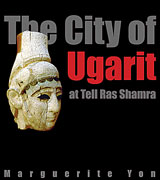The City of Ugarit at Tell Ras Shamra
Marguerite Yon
In 1929, a farmer accidentally discovered a tomb near the Mediterranean coast of Syria, about 12 km north of the modern seaport of Latakia. Initial excavations at the tell of Ras Shamra by René Dussaud and Claude Schaeffer brought to light impressive architectural remains, numerous artifacts, and tablets written in cuneiform (both alphabetic and syllabic), and the excavators soon were able to identify the site as the ancient city of Ugarit. Much of the material remains came to be dated to the end of the Late Bronze Age, from the 14th century through the 12th century B.C.E., and the religious, economic, and mythological texts from that era have had a major effect on our understanding of the history of the late 2nd millennium. However, by that time the site had already seen more than 6,000 years of occupation, and the data from Ras Shamra–Ugarit thus have become important as a reference point for the early history of the Near East along the Levantine coast and the eastern Mediterranean.
- Description
- Table of Contents
In this volume, Marguerite Yon, the principal investigator since the early 1970s on behalf of the French archaeological team, brings us up to date on the 70-year-long excavation of the site. During the past 25 years, much of our understanding of the site itself has changed, due to new excavations, reexcavation, and reinterpretation of prior excavations. This volume is the authoritative latest word on the data from the site and their meaning for our understanding of the importance of ancient Ugarit.
Heavily illustrated, including many black-and-white and color photographs.
Foreword: The Discovery
Introduction: History of Excavations
Chapter 1: Geography and History
The Site and Setting
Prehistory and Protohistory: 8th-2nd Millennia B.C.E.
The Kingdom and Its Written Documents 14th-12th Centuries B.C.E.
The End of Civilization ca/1185 B.C.E.
City Planning
Chapter 2: Description of the Tell
Tour of the Tell
The Royal Fortress and the City Ramparts
The Royal Zone
The House of Yabninu (The So-Called ‘South Palace’ or ‘Small Palace’)
The Northwest Area beyond the Royal Zone
The North Palace
The ‘Oven House’ and Plaza
The Residential Quarter
‘City Center’
Access to the City from the South
South City Trench
South Acropolis Trench
Persian Period Settlement
Sondage SH: A Major Stratigraphic Sounding
The Acropolis and the Great Temples
The Lower City
The East Terrace
Chapter 3: Artifacts Illustrating Official and Everyday Life
Tablets Written in Ugaritic (Alphabetic Cuneiform)
Tablets Written in Other Languages
Seals and Scarabs
Stone Statues
Metal Statues
Stone Stelae
Ivories of the Royal Palace
Objects of Ivory
Syrian Pottery
Commercial Jars
Imported Pottery from the West
Syrian Vessels Related to the Cult
Funnels Related to the Cult (Rhytons)
Cultic Objects
Cultic Objects (Clay Models and Figurines)
Faience
Stone Vases and Instruments
Stone Tools
Gold Vessels
Gold Jewelry
Prestige Weapon in Iron, Copper, and Gold
Weapons of Bronze
Tools and Instruments of Bronze
Objects from the Persian Period
Selected Bibliography and Abbreviations
Indexes
Mailing List
Subscribe to our mailing list and be notified about new titles, journals and catalogs.




